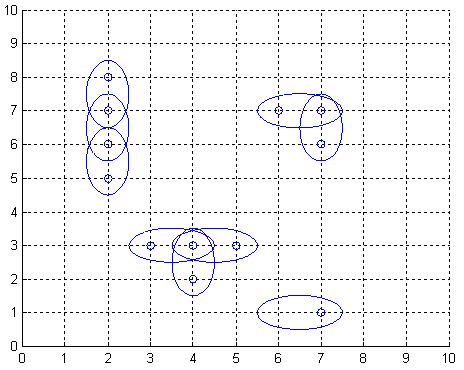Antenna Placement
| Time Limit: 1000MS | Memory Limit: 65536K | |
| Total Submissions: 4739 | Accepted: 2359 |
Description
The Global Aerial Research Centre has been allotted the task of building the fifth generation of mobile phone nets in Sweden. The most striking reason why they got the job, is their discovery of a new, highly noise resistant, antenna. It is called 4DAir, and comes in four types. Each type can only transmit and receive signals in a direction aligned with a (slightly skewed) latitudinal and longitudinal grid, because of the interacting electromagnetic field of the earth. The four types correspond to antennas operating in the directions north, west, south, and east, respectively. Below is an example picture of places of interest, depicted by twelve small rings, and nine 4DAir antennas depicted by ellipses covering them.

Obviously, it is desirable to use as few antennas as possible, but still provide coverage for each place of interest. We model the problem as follows: Let A be a rectangular matrix describing the surface of Sweden, where an entry of A either is a point of interest, which must be covered by at least one antenna, or empty space. Antennas can only be positioned at an entry in A. When an antenna is placed at row r and column c, this entry is considered covered, but also one of the neighbouring entries (c+1,r),(c,r+1),(c-1,r), or (c,r-1), is covered depending on the type chosen for this particular antenna. What is the least number of antennas for which there exists a placement in A such that all points of interest are covered?

Obviously, it is desirable to use as few antennas as possible, but still provide coverage for each place of interest. We model the problem as follows: Let A be a rectangular matrix describing the surface of Sweden, where an entry of A either is a point of interest, which must be covered by at least one antenna, or empty space. Antennas can only be positioned at an entry in A. When an antenna is placed at row r and column c, this entry is considered covered, but also one of the neighbouring entries (c+1,r),(c,r+1),(c-1,r), or (c,r-1), is covered depending on the type chosen for this particular antenna. What is the least number of antennas for which there exists a placement in A such that all points of interest are covered?
Input
On the first row of input is a single positive integer n, specifying the number of scenarios that follow. Each scenario begins with a row containing two positive integers h and w, with 1 <= h <= 40 and 0 < w <= 10. Thereafter is a matrix presented, describing the points of interest in Sweden in the form of h lines, each containing w characters from the set ['*','o']. A '*'-character symbolises a point of interest, whereas a 'o'-character represents open space.
Output
For each scenario, output the minimum number of antennas necessary to cover all '*'-entries in the scenario's matrix, on a row of its own.
Sample Input
2 7 9 ooo**oooo **oo*ooo* o*oo**o** ooooooooo *******oo o*o*oo*oo *******oo 10 1 * * * o * * * * * *
Sample Output
17 5
Source
二分图重要的是建图的过程。。。实现起来很简单的。
相邻的进行建图。
而且建了无向图,所以最后要处于2.
#include<stdio.h> #include<algorithm> #include<string.h> #include<iostream> using namespace std; /* ************************************************************************** //二分图匹配(匈牙利算法的DFS实现) //初始化:g[][]两边顶点的划分情况 //建立g[i][j]表示i->j的有向边就可以了,是左边向右边的匹配 //g没有边相连则初始化为0 //uN是匹配左边的顶点数,vN是匹配右边的顶点数 //调用:res=hungary();输出最大匹配数 //优点:适用于稠密图,DFS找增广路,实现简洁易于理解 //时间复杂度:O(VE) //***************************************************************************/ //顶点编号从0开始的 const int MAXN=510; int uN,vN;//u,v数目 int g[MAXN][MAXN]; int linker[MAXN]; bool used[MAXN]; bool dfs(int u)//从左边开始找增广路径 { int v; for(v=0;v<vN;v++)//这个顶点编号从0开始,若要从1开始需要修改 if(g[u][v]&&!used[v]) { used[v]=true; if(linker[v]==-1||dfs(linker[v])) {//找增广路,反向 linker[v]=u; return true; } } return false;//这个不要忘了,经常忘记这句 } int hungary() { int res=0; int u; memset(linker,-1,sizeof(linker)); for(u=0;u<uN;u++) { memset(used,0,sizeof(used)); if(dfs(u)) res++; } return res; } //******************************************************************************/ char map[50][50]; int hash[50][50]; int main() { int T; int h,w; scanf("%d",&T); int tol; while(T--) { scanf("%d%d",&h,&w); tol=0; for(int i=0;i<h;i++) { scanf("%s",&map[i]); for(int j=0;j<w;j++) if(map[i][j]=='*') hash[i][j]=tol++; } memset(g,0,sizeof(g)); for(int i=0;i<h;i++) for(int j=0;j<w;j++) if(map[i][j]=='*') { if(i>0&&map[i-1][j]=='*')g[hash[i][j]][hash[i-1][j]]=1; if(i<h-1&&map[i+1][j]=='*') g[hash[i][j]][hash[i+1][j]]=1; if(j>0&&map[i][j-1]=='*') g[hash[i][j]][hash[i][j-1]]=1; if(j<w-1&&map[i][j+1]=='*') g[hash[i][j]][hash[i][j+1]]=1; } uN=vN=tol; printf("%d\n",tol-hungary()/2); } return 0; }